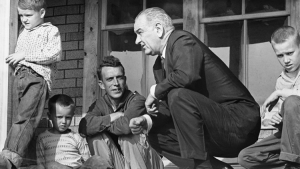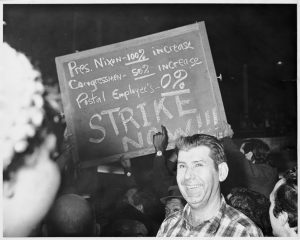Lyndon B. Johnson in Martin County, Kentucky (1964)

This famous photo depicts President Lyndon B. Johnson sitting on the porch of Mr. Tom Fletcher’s home in Inez, Kentucky on April 24, 1964. Mr. Fletcher is explaining the economic difficulties surrounding his area of residence. A primary focus of President Johnson’s presidency was what he called the “War on Poverty.” With a national poverty rate hovering around nineteen percent, Johnson felt that government involvement could address the issue plaguing the American economy, much like the intervention seen under the New Deal instituted by FDR. In order to understand the harsh realities of the struggling American, Johnson travelled to impoverished areas and spoke with common folk so he could better design a plan to alleviate the pains they experienced. The program aimed to foster economic growth in the form of job training programs and through community action. However, the misappropriation of funds and lack of focus on areas in need created divisions across the United States and forced Johnson to abandon the program shortly thereafter. Yet, the principles behind Johnson’s program were a stark contrast to those of his predecessors; having elected traditionally minimalist government supporters to the Oval Office in previous terms, Johnson returned to a pro-government intervention mindset that had not been seen since the 1930s. This reintroduction to a large, proactive government mentality remained present throughout Johnson’s term.
U.S. Postal Worker on Strike, 1970 (March 1970)

This photo depicts a postal worker who is striking during March of 1970. Largely considered a success for the employees, the strike was a direct response to collective bargaining restrictions. Feeling wages were too low, work conditions poor and unsanitary, and benefits less than acceptable, postal workers went on strike for over a week. With the majority of workers being of African American descent after many Caucasian workers left the previous decade to find higher paying jobs, the strike spurred a spike in pay for minorities. The protest was in direct response to a four percent raise in wages when Congress had given itself a forty-one percent raise. In an attempt to deliver mail and disrupt the strike, President Richard Nixon employed the services of the National Guard and armed forces. The strike led to the opportunity to collectively bargain through unions, which in turn, gave increased power and rights to workers and union members.
